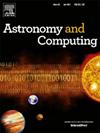Impact of ghost dark energy on cosmic evolution in f(Q, L m) theory
IF 1.8
4区 物理与天体物理
Q2 ASTRONOMY & ASTROPHYSICS
引用次数: 0
Abstract
The primary aim of this research is to explore the ghost dark energy model in the framework of (Q, L m) gravity, where Q represents the non-metricity scalar and L m denotes the matter-Lagrangian density. To achieve this objective, we investigate the homogeneous and isotropic universe with an ideal matter distribution. We examine a scenario with interacting fluids that encompass both dark energy and dark matter in this context. Further, we reconstruct (Q, L m) model to examine the effects of this extended gravitational framework on the cosmic evolution. We explore the behavior of numerous cosmic parameters corresponding to distinct parametric values. The viability of the ghost dark energy model is evaluated by the matter contents, revealing that it supports the fast expansion of the cosmos. Furthermore, the statefinder and standard diagnostic pairs are used to study the various cosmic eras. This study offers novel perspectives on the correlation between dark energy models and modified gravity theories, thereby enhancing our comprehension of cosmic evolution. Our results align with recent observational evidence, indicating that the (Q, L m) model effectively characterizes dark energy and cosmic evolution.
f(Q, L m)理论中暗能量对宇宙演化的影响
本研究的主要目的是探索f(Q, L m)引力框架下的幽灵暗能量模型,其中Q表示非度规标量,L m表示物质-拉格朗日密度。为了实现这一目标,我们研究了具有理想物质分布的均匀和各向同性宇宙。我们研究了一个场景与相互作用的流体,包括暗能量和暗物质在这种情况下。进一步,我们重建了f(Q, L m)模型,以检验这种扩展的引力框架对宇宙演化的影响。我们探索对应于不同参数值的众多宇宙参数的行为。幽灵暗能量模型的可行性通过物质含量进行评估,揭示了它支持宇宙的快速膨胀。此外,还使用状态探测器(r,s)和标准诊断对(ωD - ωD ')来研究不同的宇宙时代。这项研究为暗能量模型和修正引力理论之间的相关性提供了新的视角,从而增强了我们对宇宙演化的理解。我们的结果与最近的观测证据一致,表明f(Q, L m)模型有效地表征了暗能量和宇宙演化。
本文章由计算机程序翻译,如有差异,请以英文原文为准。
求助全文
约1分钟内获得全文
求助全文
来源期刊

Astronomy and Computing
ASTRONOMY & ASTROPHYSICSCOMPUTER SCIENCE,-COMPUTER SCIENCE, INTERDISCIPLINARY APPLICATIONS
CiteScore
4.10
自引率
8.00%
发文量
67
期刊介绍:
Astronomy and Computing is a peer-reviewed journal that focuses on the broad area between astronomy, computer science and information technology. The journal aims to publish the work of scientists and (software) engineers in all aspects of astronomical computing, including the collection, analysis, reduction, visualisation, preservation and dissemination of data, and the development of astronomical software and simulations. The journal covers applications for academic computer science techniques to astronomy, as well as novel applications of information technologies within astronomy.
 求助内容:
求助内容: 应助结果提醒方式:
应助结果提醒方式:


